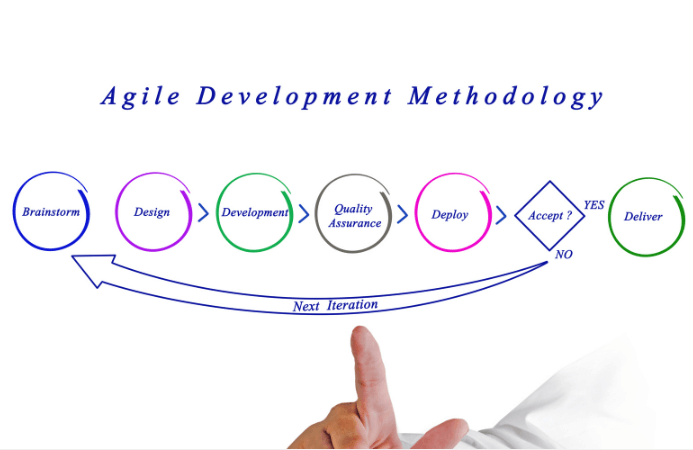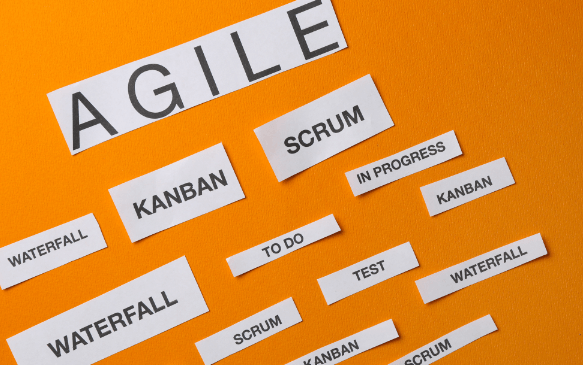
Starting your new tech business? If so, you must familiarize yourself with some SDLC-related technical terms (Stages of System Development Life Cycle). The SDLC is very important for accomplishing any tech development project, whether it’s related to software or hardware.
You might have heard of the term “Agile approach in SDLC,” but what is it? As the name suggests, it revolves around speeding up the SDLC cycle. Now, the question here is why it is important in the first place, and even if it is, how can it help a startup to grow and succeed?
What is Agile and Why It is Important?
Like SDLC, Agile is also a development process that helps entrepreneurs and many custom software development companies complete their projects in less time and under the given budget.
Today, tech development is at its peak, and day by day, new technologies are emerging. Now, if you want to create a system or a large app and if you’re following the traditional waterfall method, you won’t be able to complete the project before a year. So partaking in SAFe POPM certification training can give you the tools you need to help streamline your project processes and speed up the production of your projects.
Yeah! You heard it right. As the waterfall method is a sequential process, you can move to the next phase without completing one. So, moving from all the seven key stages of the system development life cycle will drag you for a long.
Now, if you ditch waterfall, the best and most suggested alternative you get is the Agile method. Despite completing each phase to 100%, you can leave it partially incomplete and do the rest of the work later.
How Agile Method Works?

Let’s understand this with an example. Suppose we have to create software and we have only five months to launch it.
What we will do is follow the planning phase (1st phase of SDLC) and use Agile prioritization techniques such as MoSCoW. However, there are many prioritization techniques you can use, but we are using MoSCow here.
- Must-haves (M): Features critical for the initial app release, without which the app won’t be functional.
- Should-haves (S): Important features that enhance the app’s value but can be deferred if necessary.
- Could-haves (C): Features that would be nice to have but are not essential for the first release.
- Won’t-haves (W): Features that are explicitly not part of the initial release scope.
Once we are done prioritizing, we will launch the app with the Must Have (M) features. This will be the alpha version of the app. In the first sprint, the team will discuss the feedback and reviews received from the stakeholders for the alpha version of the app.
Sprint is a delivery cycle in which the development team showcases the current version of the app, takes feedback, and discusses the required feature addition or removal. Each sprint takes one and four weeks.
If it gets passed, the Should Have (S) features will be added to the app, and this would be the beta version. This can also be launched for the end users to receive effective feedback and further maintenance if required.
Subsequent sprints continue to implement features based on their MoSCoW priority. The whole procedure takes only a few months, and you will be able to create an effective application with limited time and budget.
Benefits a Startup Can Get From the Agile Method?
Here are some benefits suggested by one of the top custom software development companies, Intetics.
- Faster Time-to-Market: Agile allows startups to develop and release Minimum Viable Products (MVPs) quickly. This means getting a basic version of your product into the hands of users sooner, helping you gather valuable feedback and gain a competitive edge.
- Adaptability: Users demand change with time. It’s dynamic! With the Agile approach, you can connect with stakeholders and users and get regular feedback. So, you can respond rapidly to changing market conditions, and your product will always be relevant to users.
- Customer-Centric: Agile places a strong emphasis on involving customers in the development process. This customer-centric approach helps startups create products that better meet user needs and preferences.
- Continuous Improvement: Agile encourages regular reflection and adaptation through practices like sprint retrospectives. Startups can use this feedback loop to continually enhance their processes and product quality.
- Efficient Resource Utilization: Agile helps in the efficient allocation of resources by focusing on high-priority tasks and features. This prevents wasting time and money on low-value or unneeded elements.
- Reduced Risk: By splitting down the project into smaller, manageable increments, startups can identify and address issues early. So, the chances of costly project failures will be less.
- Enhanced Collaboration: Agile promotes collaboration among cross-functional teams, ensuring that everyone is aligned with the project’s goals. This synergy can lead to faster problem-solving and better decision-making.
- Transparency: Stakeholders, including investors, can have clear visibility into project progress, which can build trust and confidence.
- Cost Control: Agile enables startups to prioritize and deliver the most critical features first, helping to manage development costs more effectively.
- Improved Product Quality: Frequent testing and feedback loops in Agile result in a higher-quality product.
Bottom Line
Competition is everywhere! So, if you want to stand out in this industry, you have to catch the speed. Intetics works closely with such techniques to complete many tech projects. That’s why it has been the leading tech brand for several years. To learn more about Intetics and its services, visit Intetics.com today!